Transient state thermal analysis of a 4 stroke CI engine Piston
Harsh Vardhan1 , Gaurav Kumar Netam2 , Jayant3 , Pushpendra Singh41Student, B. Tech (Mechanical Engineering), Delhi Technological University, New Delhi, India
2 Student, B. Tech (Mechanical Engineering), Delhi Technological University, New Delhi, India
3 Student, B. Tech (Mechanical Engineering), Delhi Technological University, Rohtak, Haryana, India
4Associate Professor, Dept. of Mechanical Engineering, Delhi Technological University, New Delhi, India

Abstract - This studyemploys ANSYS software to conduct a comparative investigation of the thermal behavior of an internal combustion (IC) engine piston made of four different materials, Aluminium Alloy, AlSi10Mg, Titanium Alloy (Ti-6Al-4V) and Gray Cast Iron. The goal is to examine the thermal behavior of the piston built of each material under various operating circumstances. The temperature distribution and heat flux within the piston for each material are the main topics of the simulations, which also consider a variety of boundary conditions. Results are given, compared, and their implications for choosing materials for IC engine piston applications are examined. This study illustrates the capability of ANSYS in simulating and comparing the thermal behavior of intricate mechanical systems and offers insightful information about the comparative thermal behavior of an IC engine piston constructedoffourdifferentmaterials.
Key Words: IC Engine, Heat flux, Temperature Distribution
1.INTRODUCTION
The design and material choices used for internal combustion (IC) engine parts like pistons have a significantimpactontheengine'soveralleffectivenessand performance.ThermalbehaviorofICenginepistonsisone of the crucial elements that might have a considerable impact on their performance. The engine's overall performance and dependability may be impacted by the hightemperaturesandpressuresthepistonissubjectedto during operation. These conditions can also lead to material degradation and thermal strains The thermal behavior of an IC engine piston made of four different materials Aluminumalloy,AlSi10Mg,TitaniumAlloy(Ti6Al-4V)andGrayCastIron iscompared inthis research using the ANSYS program. The goal is to examine the thermal responseofthepistonmadeofeachmaterial and offer details on how an IC engine piston made of various materials compares thermally. The study focuses on the temperature and thermal stresses within the piston for each material, while the simulations consider various thermalloadsandboundaryconditions.
The findings of this study offer useful knowledge for engineers engaged in IC engine design and optimization. Thisstudycanassistengineersinmakingthebestmaterial choice for the piston to achieve the desired performance anddependabilityoftheenginebyevaluatingthethermal behavior of the piston constructed of various materials. The thermal behavior of the pistons in IC engines may be studiedusingtheANSYSsimulationsinaneconomicaland effectivemanner,whichiscrucial asengineefficiencyand environmentalrestrictionsbecomemorestringent.
1.1 Piston Terminology
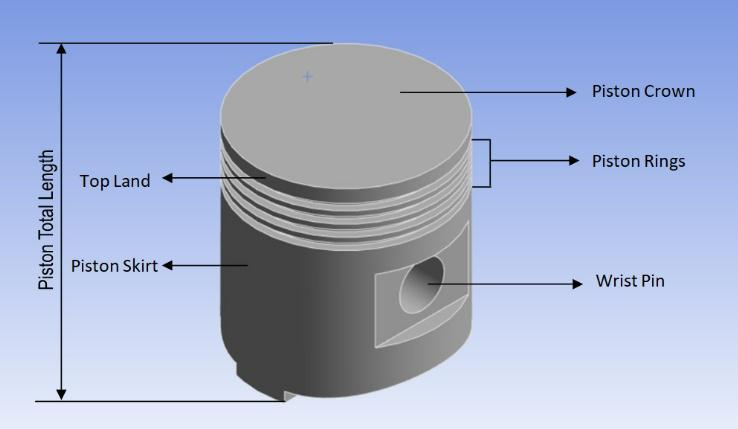
The crown,whichisthetopofthepiston,ismade to resist the high pressure and high temperature ofthecombustionchamber.
Thelowerpartofthepiston,calledthe skirt,acts as a guide to make sure the piston goes straight andstays intherightalignmentwiththecylinder bore.
The wrist pin, which is another name for the piston pin, joins the piston to the connecting rod and enables reciprocating movement of the piston.
Piston rings, which are used to seal the combustion chamber and transport heat to the
cylinder walls, are mounted to the piston's outer circle.
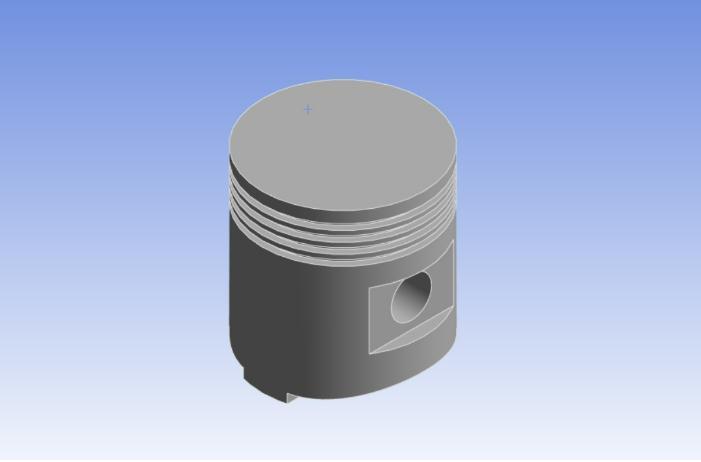
The total length of the piston is length from piston crown to bottom of piston. Sum of the length of the upper platform, the length of the annularsectionandthelengthoftheskirt.
The portions on the piston between the piston rings known as "ring lands" give the rings structural support and keep them from spinning withinthepistongroove.

The piston rings are held in position by the machining channels in the ring grooves of the piston.
1.2 Piston Design
Internalcombustionenginepistondesignisacomplicated procedure that considers a variety of aspects in order to obtain the best performance and efficiency. For the purposeofthisanalysis,wehavetakendimensionsofa4stroke diesel engine piston into account. We have used ANSYSsoftwareforthepurposeofdesign.
2. Transient State Thermal Analysis
Thermal analysis of pistons is done to assess how well they can tolerate the high temperatures and thermal stresses that occur during engine running. We can find possibleweakspotsinthepistondesignandstrengthenit forbetterheatdissipationanddecreasedthermalstresses byassessingtemperaturedistributionandheatflux

2.1. Selection of Material
Considerationofseveral parameters,includingasthermal conductivity, specific heat capacity, thermal expansion coefficient, and strength, is necessary when choosing a materialforapiston'sthermalanalysis.Thebestmaterials toemployinpistonsarethosethathavethecorrectmixof these characteristics, resulting in an engine that runs reliablyand effectively. Materials usedforthisprojectare Aluminium alloy, AlSi10Mg, Titanium alloy (Ti-6Al-4V) andGraycastiron.
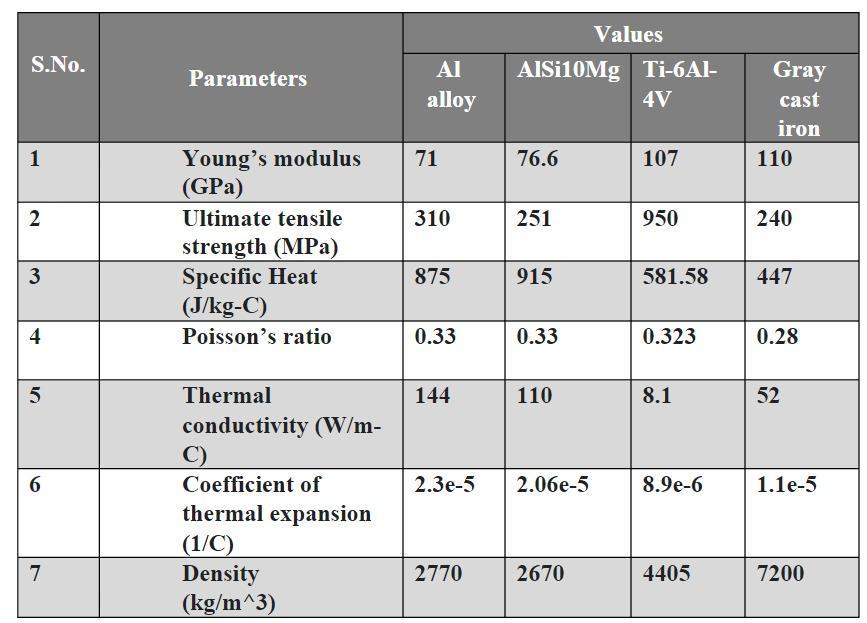
2: Materials Properties
2.2. Generating Mesh
To generate mesh, the default mode was used with tetrahedral elements, the solid model being meshed into 23290elementsand41502nodes.
3. RESULTS
Wehaveperformedtransientstatethermalanalysisonthe piston and compared results of four materials with the boundary condition of temperature being set as 400°C at thetopofpiston.
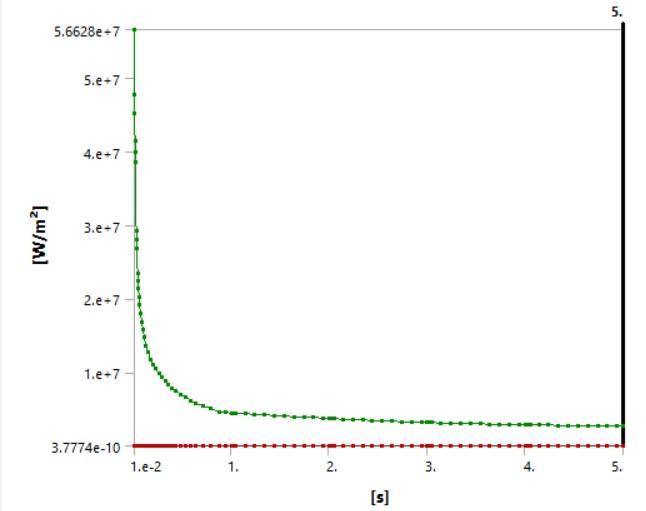
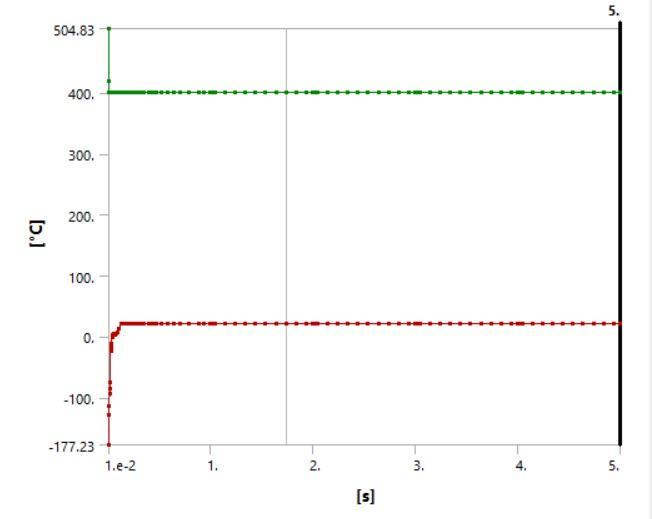
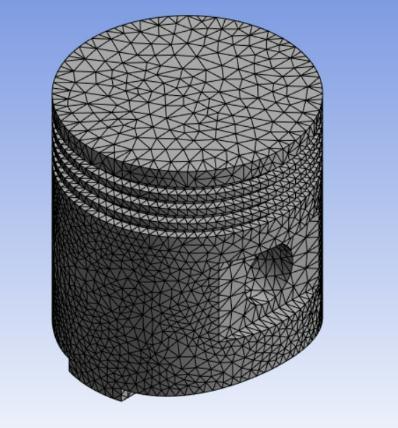


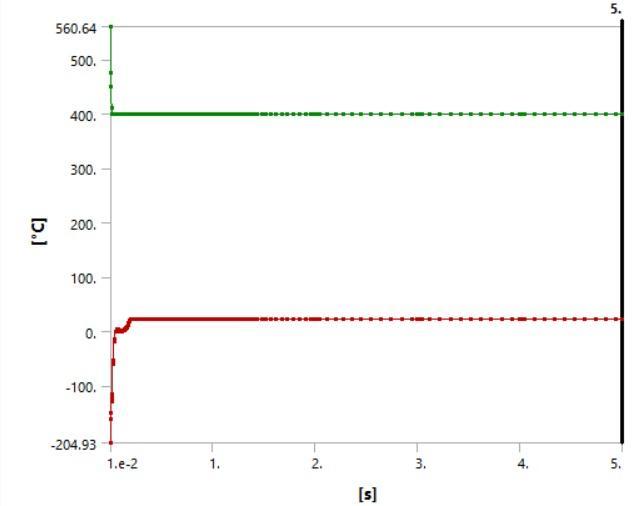
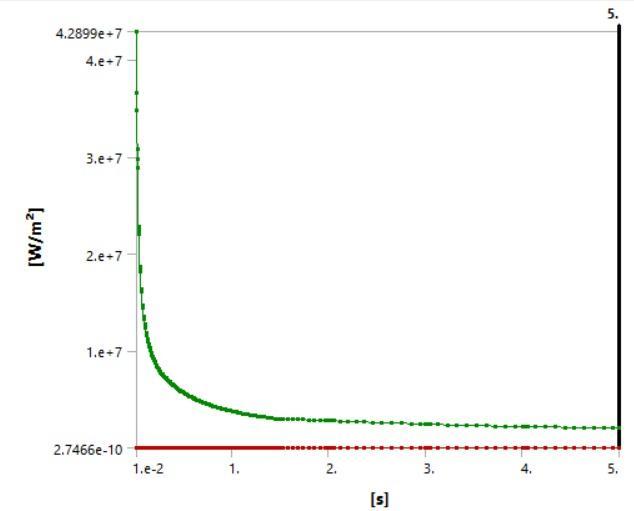
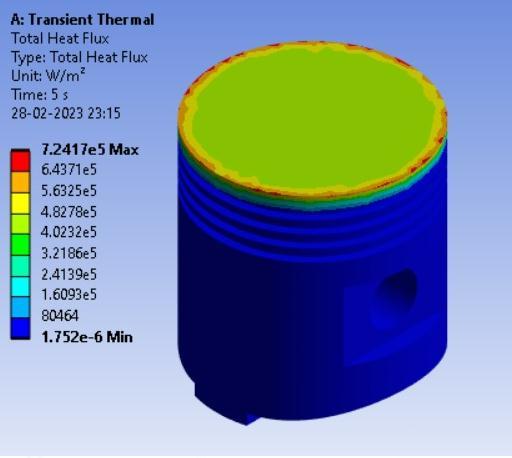

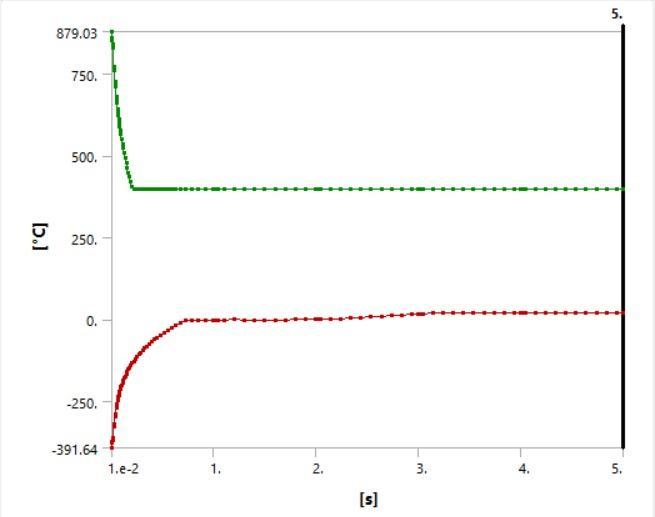

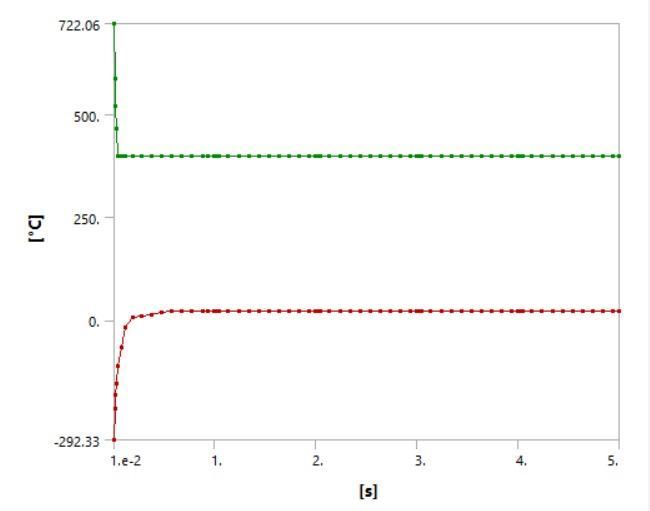
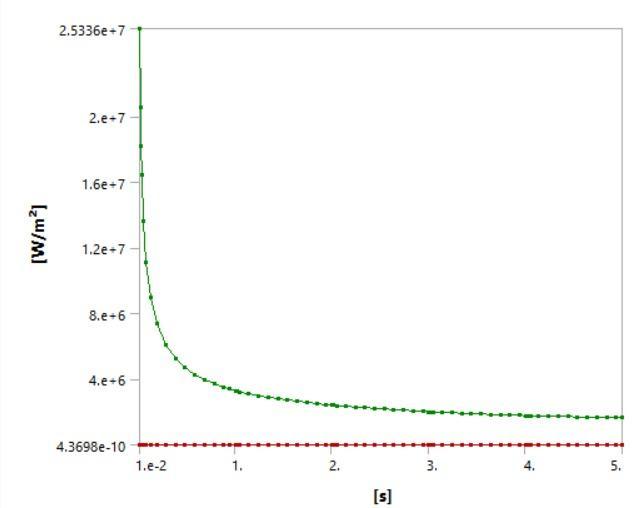
The results from the transient state thermal analysis of pistonarepresentedinatabularformatbelow:
(7.2417e5 W/m2), indicating that it would be subject to less thermal stress and deformation than the aluminium alloy. However, the titanium piston may not be as efficient at dispersing heat underlow-loadcircumstances,asindicatedbythe minimumheatfluxvalueof1.752e-6W/m2.
Forboth the lowestandmaximum heat flux,grey cast iron and the AlSi10Mg alloy have intermediate values. In comparison to titanium alloy, the AlSi10Mg alloy has a higher maximum heat flux value, but a lower minimum heat flux value. The grey cast iron has a lower maximum heatfluxvaluethantheothermaterials,butitalso has a lower minimum heat flux value, suggesting that its temperature distribution may be more consistent.
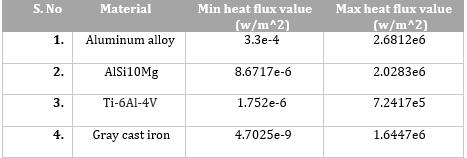
The results of the thermal study of pistons constructed of various materials offer some intriguing new information about how well these materials transport heat. The substance that transfers heat the fastest is aluminium alloy, which has a maximum heat flux value of 2.6812e6 w/m2. The closest competitor, AlSi10Mg, has a maximum heatfluxvalueof2.0283e6w/m2.Themaximumheatflux values for Ti-6Al-4V and grey cast iron are lower, at 7.2417e5w/m2and1.6447e6w/m2,respectively.
CONCLUSION
Thealloymadeofaluminiumhasamaximumheat flux value of 2.6812e6 W/m2, which is the highest. This shows that under specific operating situations, the aluminium alloy piston may face highheatloads,whichcouldcausethermal stress and deformation. Nonetheless, the aluminium piston is also capable of effectively dispersing heat and maintaining lower temperatures under typical working conditions, as indicated by the lowestheatfluxvalueof3.3e-4W/m2.
The Ti-6Al-4V alloy, in contrast, has a maximum heat flux value that is substantially lower
The materials' thermal conductivity and specific heat capacity are to blame for these outcomes. In comparison to Ti-6Al-4V and grey cast iron, aluminium alloy and AlSi10Mg have stronger thermal conductivities allowing them to transmit heat more effectively.Itiscrucialtorememberthattheseresults do not necessarily represent the materials' general performanceinapistonapplication.Whilechoosinga materialforpistonmanufacture,otheraspectssuchas mechanical qualities, price, and availability should also be taken into consideration. Overall, the study's findings can help engineers and designers make knowledgeable selections when choosing materials forpistonapplications.
REFERENCES
1. Balahari Krishnan S, Aezhisai Vallavi MS, Arunkumar M and Haripraveen A - “Design and Analysis of an IC Engine Piston using Composite Material “European Journal of Advances in EngineeringandTechnology,2017,4(3):209-215 ISSN:2394-658X
2. Preeti Kumari, Anamika, Dr.H.C.Thakur, “Thermal Analysis of Piston of IC engine” International Journal of Scientific & Engineering Research, Volume 7, Issue 12, December-2016, ISSN 22295518,PAGE374-381
3. B.A.Devan, G.Ravindra Reddy,”Thermal analysis of Aluminum alloy Piston”, International Journal of Emerging Trends in Engineering Research (IJETER),Vol.3No.6,Pages:511-515(2015)
4. K. Mayandi, R. Muneendra Reddy, B. Jaya Harsha Vardhan, Y. Anand Babu,” STATIC AND THERMAL ANALYISIS OF PISTON USING ANSYS WITH

VARIOUS MATERIALS” International Research Journal of Modernization in Engineering Technology and Science, Volume:03/Issue:05/May-2021, Impact Factor5.354,PAGE3035-3044
5. Prashant Kumar, PG Scholar, Abhishek Bhandari, Sunil Kumar Chaturvedi,” Design and thermal analysis of ic engine piston design using catia and Ansys software” SSRG International Journal of Mechanical EngineeringVolume6 Issue10, 12-19, October2019ISSN:2348–8360
6. Atthuru Kalyan , Dr. D. R. Srinivasan,” Static and Thermal Analysis of a Piston with Different ThermalBarrierCoatings”,InternationalJournalof Scientific Engineering and Research (IJSER) ISSN (Online):2347-3878ImpactFactor(2020):6.733
7. Thirakavinod Kumar, B. Ravisekhar,“Thermal & Static Analysis On IC Engine Piston Using Fea”, IJATES,Issn2348-7550,Volume 4, Issue No. 12,December-2016,Page.No.225-231
8. Yash Dhamecha, Vaibhav Saptarshi, Shubham Parikh, Tejasve Parnami,” Design and Analysis of Piston using Different Materials”, International Research Journal of Engineering and Technology (IRJET) e-ISSN: 2395-0056 Volume: 07 Issue: 12 | Dec2020p-ISSN:2395-0072

9. Ajay Raj Singh*, Dr. Pushpendra Kumar Sharma, Design, Analysis and Optimization of Three Aluminium Piston Alloys Using FEA “Journal of Engineering Research and Applications www.ijera.com ISSN : 2248-9622, Vol. 4, Issue 1( Version3,January2014,pp.94-102
10. A.R.Bhagat,Y.M.Jibhakate“ThermalAnalysisAnd Optimization of I.C. Engine Piston Using finite Element Method “International Journal of Modern Engineering Research (IJMER) vol.2, Issue.4, JulyAug2012pp-2919-2919ISSN:2249-6645
11. Mr.Jadhav Vishal, Dr. R.K. Jain, Mr. Yoge A.ndra S.Chauhan,” DESIGN AND ANALYSIS OF ALUMINUM ALLOY PISTON USING CAE TOOLS”, “INTERNATIONAL JOURNAL OF ENGINEERING SCIENCES & RESEARCH TECHNOLOGY, ISSN: 2277-9655 Impact Factor: 4.116 [Vishal*et al., 5(7):July,2016]ISSN:2277-9655IC™Value:3.00
12. PAGADALA SIDDIRAJU, KOPPULA VENKATESWARAREDDY “DESIGN AND ANALYSIS OF THE PISTON BY USING FIVE DIFFERENT MATERIALS”, INTERNATIONAL JOURNAL OF
ADVANCE SCIENTIFIC RESEARCH AND ENGINEERING TRENDS || Volume 6 || Issue 2 || February2021||ISSN(Online)2456-0774
13. Subodh Kumar , SRCEM, Banmore M.P. India; C. S. Koli, SRCEM, Banmore M.P. India “A Review Paper on Thermal Analysis of Piston by Finite Element Analysis” IJSRD - International Journal for Scientific Research & Development| Vol. 5, Issue 12,2018|ISSN(online):2321-0613
14. Pathipati Vasu, Dr.M.Sri Rama Murthy, P.S.Amarnadh, “Design and Analysis of IC Engine Piston with Different Materials”, International Journal of Research e-ISSN: 2348-6848 p-ISSN: 2348-795XVolume05Issue07March2018
15. V G Cioată, I Kiss, V Alexa and S A Rațiu, “Mechanical and thermal analysis of the internal combustion engine piston using Ansys” International Conference on Applied Sciences (ICAS2016), V G Cioată et al 2017 IOP Conf. Ser.: Mater.Sci.Eng.163012043
16. Valentin Mereuta,” Static and Thermal Analysis of Piston using FEM Analysis” International Journal for Research in Applied Science & Engineering Technology (IJRASET) ISSN: 2321-9653; IC Value: 45.98; SJ Impact Factor :6.887 Volume 6 Issue I, January2018
17. J. Srikanth, Mr. A. Jithendra Kumar, “Modeling and Static Thermal Analysis of IC Engine Piston by using Different Materials”, International Journal of Applied Sciences, Engineering and Management ISSN 2320 – 3439, Vol. 06, No. 02, April 2017, pp. 265–272
18. Kunal Saurabh1*, Saurabh Kumar Rai1, Shravan Yadav1, Sanjay Kumar Yadav1 , AkhandPratap Singh1, “A Review Paper on Design Analysis of Internal Combustion Component, International journal of adavance research in science and engineering vol no.6 Special issue no.2, december 2017,ISSIN2319-8354
19. Satish Sharma, P.S. Dhakar,” A Review Study of Steady State Thermal Analysis of Piston by Finite Element Method (FEM)” International Journal of I.C.EnginesandGasTurbinesVol.3:Issue1
